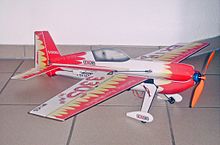Shock Flyer

from Ikarus (0.8 m wingspan).
Modeled after the Extra 330s from Walter Extra .
A Shockflyer (of English .: shock "shock", "Scandals" and flyers "Wings") is a radio-controlled aerobatic and 3D-capable model airplane lightweight, specifically for the indoor flying is constructed (indoor flying).
control
A shock flyer is controlled by elevator , rudder and ailerons . Usually one servo is used for both ailerons together .
With the controllable pitch propeller - also known as the VPP system (variable pitch prop) - a further control option was developed, particularly for competitive models. The controllable pitch propeller is controlled by an additional servo and works like the blade adjustment of a helicopter . This allows the model to fly backwards without changing the direction of rotation of the motor.
Thrust-to-weight ratio
An important Shock-Flyer characteristic is the thrust-to-weight ratio . If the value is above one, the drive generates more thrust than the model weighs. Usually Shock Flyers have a thrust-to-weight ratio of 1.5: 1 to 5: 1.
drive
In order to achieve a thrust-to-weight ratio of over one, Shock Flyers are usually operated by small brushless electric motors ( brushless motors ) and lithium polymer batteries (LiPo) in special battery packs .
construction
The basic idea of the construction is the use of, with carbon rods reinforced and stabilized Depron (or Selitron) for the cross fuselage and the surfaces. Often, additional Depron pieces are attached to the wings as guide surfaces in order to improve the flight characteristics in certain flight situations.
Technical specifications
The take-off weight of the standard constructions is 25 g to 200 g, the wingspan is approx. 0.8 m. But there are also models with a span of up to 2 m, which then weigh 400 g to 1000 g.
history
The classic Shock Flyer goes back to the multiple German indoor aerobatic master Martin Müller, according to whose design Shock Flyers have been offered by the Ikarus company since 2002. The type was then offered in a similar design by many companies and also further developed in terms of stability and flight characteristics; Complete self-assembly by cutting the required parts from Depron plates is also common.
What is possible
With a competition Shockflyer (thrust-to-weight ratio greater than 4: 1 and variable pitch propeller ) may by experienced pilots in a confined space role , loop , turn , Cuban eight , Rolling circle , Torque role , role loop, snap roll , knife-edge , snap, Inverted Spin, knife spin, tic-tooc, slip, inverted hover, waterfall, negative looping, lying figure eight in knife flight and much more.
